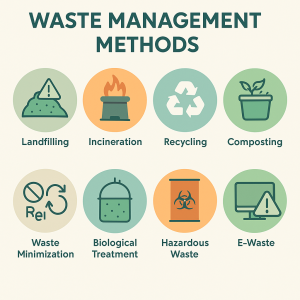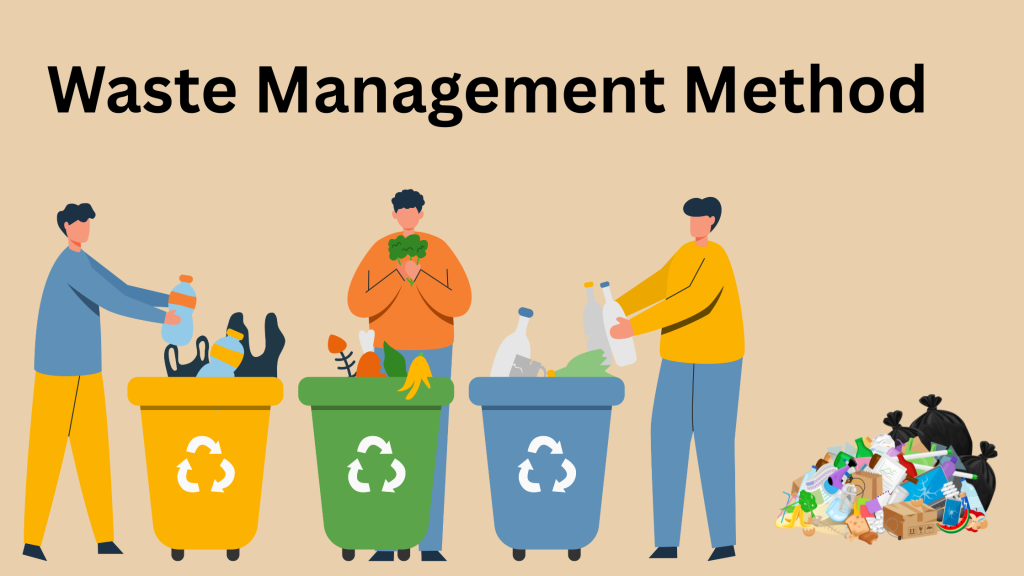Waste is an inevitable byproduct of human activity, from households and industries to construction sites and agricultural practices. As global populations grow, effective waste management methods have become more important than ever to protect human health, preserve natural resources, and ensure a sustainable future.
In this blog, we’ll explore the most common and effective waste management methods used today, along with their benefits and challenges.
What is Waste Management?
Waste management refers to the collection, transportation, treatment, and disposal of waste, along with monitoring and regulation. It also includes the efforts to reduce waste generation and promote recycling and reuse. The goal is to minimize the negative impact of waste on the environment, society, and economy.

1. Landfilling
What It Is:
Landfilling involves burying waste in designated areas of land, often in large pits lined to prevent contamination of soil and groundwater.
Pros:
-
Simple and cost-effective
-
Can handle large volumes of waste
Cons:
-
Produces methane, a potent greenhouse gas
-
Can lead to groundwater contamination if not managed properly
2. Incineration
What It Is:
Incineration involves burning waste at high temperatures in controlled environments. The process reduces waste volume and can generate energy.
Pros:
-
Reduces waste volume by up to 90%
-
Produces energy (waste-to-energy plants)
Cons:
-
Can emit harmful gases if not properly controlled
-
High operational costs
3. Recycling
What It Is:
Recycling converts waste materials into new products. Common recyclable materials include paper, glass, metal, and certain plastics.
Pros:
-
Conserves natural resources
-
Reduces energy consumption
-
Decreases landfill use
Cons:
-
Requires sorting and clean materials
-
Not all waste is recyclable
4. Composting
What It Is:
Composting is the natural process of decomposing organic waste—like food scraps and garden waste—into nutrient-rich soil.
Pros:
-
Reduces landfill waste
-
Produces natural fertilizer
-
Easy to do at home or on a community scale
Cons:
-
Only suitable for organic waste
-
Can produce odors if not managed correctly
5. Waste Minimization (Reduce and Reuse)
What It Is:
This method focuses on reducing the amount of waste generated and reusing items to extend their lifecycle.
Pros:
-
Most environmentally friendly
-
Saves money and resources
Cons:
-
Requires behavior change and awareness
-
May not always be convenient
6. Biological Treatment
What It Is:
This method uses microorganisms to break down biodegradable waste in the absence (anaerobic) or presence (aerobic) of oxygen.
Pros:
-
Can generate biogas as a renewable energy source
-
Environmentally sustainable
Cons:
-
Suitable mainly for organic waste
-
Requires controlled conditions
7. Hazardous Waste Management
What It Is:
Specialized methods for handling harmful materials like batteries, chemicals, medical waste, and electronic waste (e-waste).
Pros:
-
Protects health and the environment
-
Complies with legal regulations
Cons:
-
Expensive and requires specialized facilities
-
Complex logistics and handling procedures
Adopting the right waste management methods is crucial for a cleaner, healthier planet. From landfilling and incineration to recycling, composting, and reducing waste at the source, each method plays a role in the broader strategy to manage our growing waste problem. By understanding and implementing these practices in our daily lives, communities and industries can contribute to a more sustainable and eco-friendly future.
Our Ecomaster Can Help You in Waste Maagement
Ecomaster Odour Control Solution is an eco-friendly, enzyme-based formula that neutralizes a broad spectrum of foul gases— including hydrogen sulfide, ammonia, amines, mercaptans, skatole, sulfur dioxide, acetaldehyde, and cadaverine. Biodegradable and versatile, it’s ideal for controlling odors in food processing plants, waste management facilities, and other industrial settings—both indoors and outdoors.


